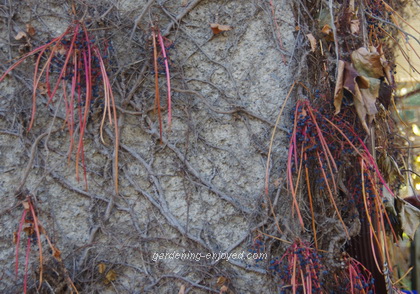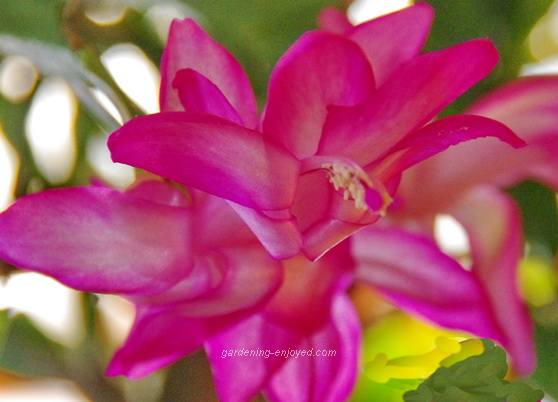
There was ice on the bottom pond this morning but the sun was shining. I wandered around the garden in my ancient gardening parka and it was a delightful stroll. Hints of frost were still in all of the shady areas and that ice was slowly leaving the pond. There was no wind and the sun was warm and bright. I will be back out there shortly working on the eternal fall clean up. It’s supposed to be much colder next week. I think I can get almost everything done in the next day or so and then move the lawnmower to the back of the garage and the snowblower to the front. I may even be clever enough to start the snowblower now to make sure it is working properly rather than sit in a cold garage cursing it, after the first significant snowfall. There were still many delights in the garden, the best Rose in the garden, it’s one of the Peace Roses, was still resplendent with about 6 blooms so it’s not ready for its
initial pruning yet. The blooms were suffering a bit from the freeze and we’ll see how they look after the sun warms them up. Against the house the Boston Ivy continues to add interest. It may be a bit rampant and in need of severe pruning each year but the benefits outweigh that bit of needed effort. The coloured leaves have all fallen but they leave their petioles behind for a few more weeks and they stand out from the house as brightly coloured shafts of light. Each season and each week brings new and sometimes subtle delights to the gardener who takes the time to observe and absorb the ever changing details.
 Inside the solarium door is the results of the last few days efforts. Of course there are bins and bags filled with composting detritus but some of that composting material had bits of gardening gold attached. Bulbs, tubers, rhizomes and even some seeds have been rescued and brought inside for their long winter’s nap. They sit in the solarium for a few days to dry the remaining soil so they will not rot during their nap. Nothing is more annoying in March than finding that the carefully dug tubers have become a mushy mess. Putting them away nicely dried and free of any soil certainly helps to avoid that mush. The Dahlias seemed to grow very large tubers this year. The Begonia boliviensis make unbelievably large tubers for the size of the plants and while that is wonderful it does take up a lot of space in March when we are trying to start them. I had two Cannas that were grown from seed this year and they have
made nice rhizomes. The one in the container doing almost as well as the one in the ground. Those rhizomes are drying in the picture. It’s endlessly fascinating to observe the many ways that Mother Nature uses to preserve and propagate.
Inside the solarium door is the results of the last few days efforts. Of course there are bins and bags filled with composting detritus but some of that composting material had bits of gardening gold attached. Bulbs, tubers, rhizomes and even some seeds have been rescued and brought inside for their long winter’s nap. They sit in the solarium for a few days to dry the remaining soil so they will not rot during their nap. Nothing is more annoying in March than finding that the carefully dug tubers have become a mushy mess. Putting them away nicely dried and free of any soil certainly helps to avoid that mush. The Dahlias seemed to grow very large tubers this year. The Begonia boliviensis make unbelievably large tubers for the size of the plants and while that is wonderful it does take up a lot of space in March when we are trying to start them. I had two Cannas that were grown from seed this year and they have
made nice rhizomes. The one in the container doing almost as well as the one in the ground. Those rhizomes are drying in the picture. It’s endlessly fascinating to observe the many ways that Mother Nature uses to preserve and propagate.

One of my Part Time Houseplants is certainly paying the rent this week and will continue to do so for several more. The Thanksgiving Cactus, Schlumbergera truncata
is in full and glorious bloom. She has moved down from her regular winter home above the cupboards to a place of prominence on the kitchen island so that we don’t miss a moment of her glory. She spent the summer outdoors in the shade of the Walnut tree and the shortening days of September and October have told her that it is time to burst forth into bloom. She has been in the house for a few weeks now because she is not fond of the cold and it is mostly day length and a bit of cool that starts her bloom cycle. Her cousin, the Christmas Cactus, Schlumbergera bridgesii is still sitting under the solarium glass where she will not receive any artificial light after the sun goes down. That will make her bloom
right on time for Christmas. The Thanksgiving Cactus tries to be a dual citizen as she starts to bloom somewhere between the Canadian and the U.S. celebrations of Thanksgiving. Both of these Cactus are called leaf cactus, their plant bodies are flattened and the leaves are actually stems. The flowers are produced from notches in these stems or from the tips. Mine are watered when they need water, which is often more than a week, depending on how much sunlight they have received. Stick your finger in the soil and if it’s damp then go away and come back another day.
Now it’s time to answer a few of my reader’s questions. Don’t forget to check the front page of the Website for frequent short ideas for current gardening activities.
Claudia Asks? I was wondering if you could give me some advice. My husband and I have an allotment garden by the Leslie Spit. He built raised
beds about 4 years ago and we've been amending the soil each spring and/or fall. There are quite a few weeds and weed seeds in the soil after four years but also lots of earthworms so I am reluctant to remove all the old soil and start again with all new soil. Can you recommend a way to battle the weeds? I notice some gardeners are covering their raised beds with landscape cloth. If we do that, when can we remove it?
Ken Answers! Weeds are a part of a gardener’s life and we all deal with them in different ways. Replacing the soil would not be a good way. Unless you could find some way to sterilize the new soil you will just be introducing new weeds. Covering the soil is a good technique. A few layers of damp newspaper is much cheaper than landscape fabric and may work better. By planting time in the spring it will be quite soft and you could leave it in place and plant through it, cutting little holes. Some weeds will always find their way up but
remember that tiny weeds are much easier and quicker to deal with than established ones. Weeding and procrastination are not good companions.
Marguerite Asks? We have a mature sweet cherry tree which blooms in the spring then has few or no cherries. The tree is 8 or 9 years old and about 20 or more feet tall. The few cherries that it does begin to produce collapse into a festering mess. We are unwilling to use weird chemicals. Do you have any idea what may be causing our lack of cherries. The tree looks otherwise quite healthy.
Ken Answers! Most sweet cherries require cross pollination. You need another tree of a different variety to pollinate your tree. It may produce a few fruit but to get a real crop it does require that cross pollination.
Mary Ellen Asks? While cutting branches in the yard for yet another Christmas Urn before the deep freeze sets in and the soil is frozen in the pots and you can't get
the branches down into the soil I spotted something yellow from a distance away and was very pleasantly surprised when I discovered that my forsythia was blooming. So I cut off the three branches and have brought them in side to enjoy. Have you ever experienced forsythia blooming Nov. 12 before??
Ken Answers! I have seen a bit of Forsythia blooming if we have an extended warm period in the fall but it is unusual. Take them in and enjoy them as those branches will not bloom again in the spring. It's snowing here at the moment as I try to convince myself to go outside and continue the cleanup.
111 Trent St. W.
Whitby ON
L1N1L9

 Inside the solarium door is the results of the last few days efforts. Of course there are bins and bags filled with composting detritus but some of that composting material had bits of gardening gold attached. Bulbs, tubers, rhizomes and even some seeds have been rescued and brought inside for their long winter’s nap. They sit in the solarium for a few days to dry the remaining soil so they will not rot during their nap. Nothing is more annoying in March than finding that the carefully dug tubers have become a mushy mess. Putting them away nicely dried and free of any soil certainly helps to avoid that mush. The Dahlias seemed to grow very large tubers this year. The Begonia boliviensis make unbelievably large tubers for the size of the plants and while that is wonderful it does take up a lot of space in March when we are trying to start them. I had two Cannas that were grown from seed this year and they have
made nice rhizomes. The one in the container doing almost as well as the one in the ground. Those rhizomes are drying in the picture. It’s endlessly fascinating to observe the many ways that Mother Nature uses to preserve and propagate.
Inside the solarium door is the results of the last few days efforts. Of course there are bins and bags filled with composting detritus but some of that composting material had bits of gardening gold attached. Bulbs, tubers, rhizomes and even some seeds have been rescued and brought inside for their long winter’s nap. They sit in the solarium for a few days to dry the remaining soil so they will not rot during their nap. Nothing is more annoying in March than finding that the carefully dug tubers have become a mushy mess. Putting them away nicely dried and free of any soil certainly helps to avoid that mush. The Dahlias seemed to grow very large tubers this year. The Begonia boliviensis make unbelievably large tubers for the size of the plants and while that is wonderful it does take up a lot of space in March when we are trying to start them. I had two Cannas that were grown from seed this year and they have
made nice rhizomes. The one in the container doing almost as well as the one in the ground. Those rhizomes are drying in the picture. It’s endlessly fascinating to observe the many ways that Mother Nature uses to preserve and propagate. 
